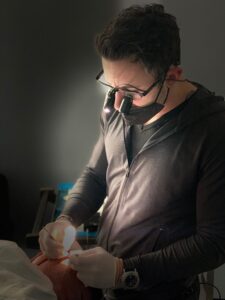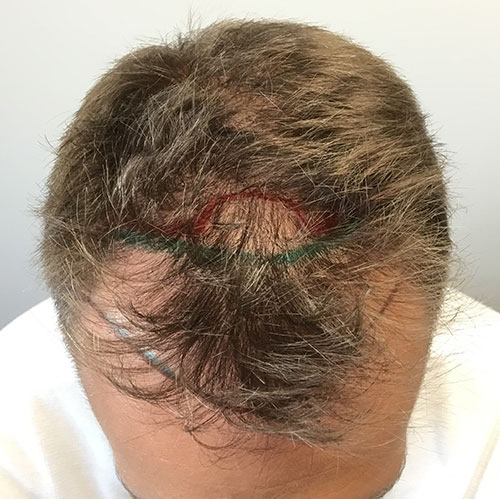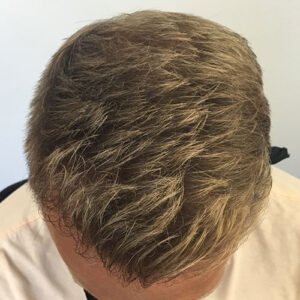Hair Transplant Surgery
As experienced hair restoration surgeons, our team at Leonard Hair Transplant Associates has treated men and women experiencing hair loss in New England for more than 30 years. Dr. Matthew Lopresti and Dr. Mary Lopresti stay current with the latest in hair transplant technology to offer you the most effective solutions and help you reach your aesthetic goals. Patient care is our highest priority and our trained staff is dedicated to exceeding patient expectations. Every single hair transplant surgery patient is treated with compassion, respect, and kindness.
Hair transplant surgery from our team is a natural-looking solution for hair loss. You can achieve the look you desire with our state-of-the-art hair restoration treatments performed by Dr. Matthew Lopresti and Dr. Mary Lopresti. Look younger, feel younger, and get your hair back with a hair transplant procedure from Leonard Hair Transplant Associates.
- What Is a Hair Transplant?
- Hair Transplant Candidates
- Hair Transplant Types
- FUE Hair Transplant Procedure
- Traditional Strip Method Hair Transplant Procedure
- Hair Transplant Recovery
- Hair Transplant Results
- Hair Transplant Scars
- Repeating Hair Transplant Surgery
- Hair Restoration for Women
- Hair Restoration for Transgender Patients
- Facial Hair Transplantation
- Non-Surgical Hair Restoration
- Additional Hair Transplant FAQs
What Is a Hair Transplant?
Hair transplant surgery is designed to restore hair loss by collecting follicles from the donor site located in the back of the head (where hair grows continuously) and placing, or transplanting, them in another area where hair no longer grows as desired. Using today’s latest advances in hair restoration methodology, hair is harvested from the donor site. We only take hair from the donor site because these hairs are programmed to grow throughout one’s lifetime. Once the hairs have been transplanted to the thinning or bald areas of the scalp they will maintain their integrity and should continue to perpetually grow.
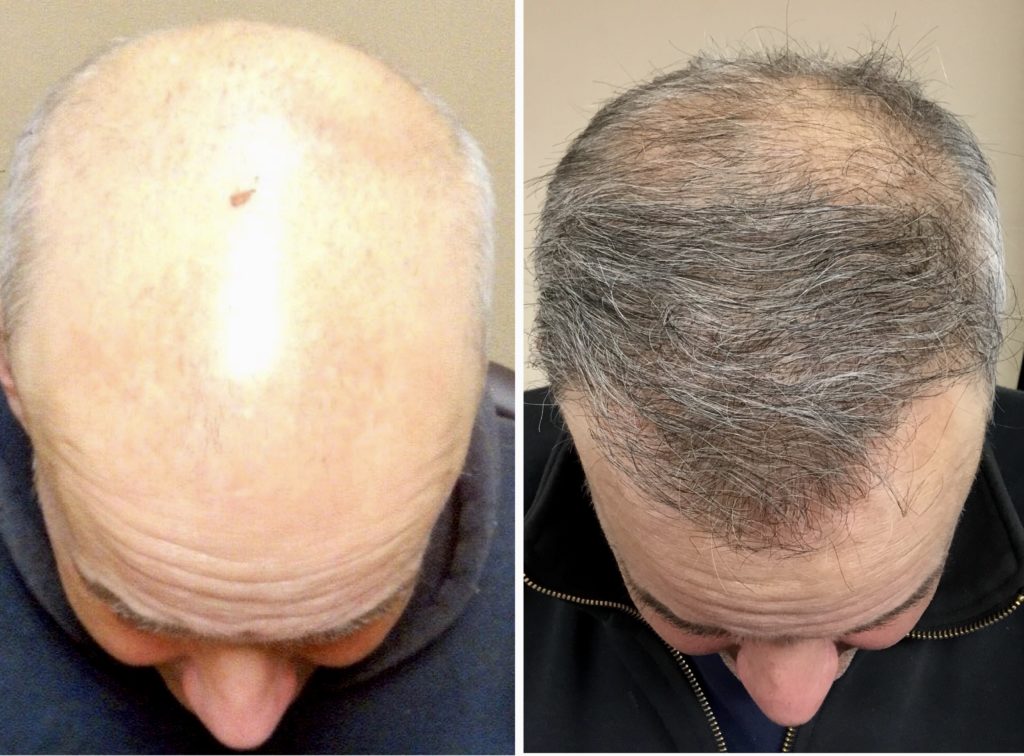
At our Massachusetts and Rhode Island surgical offices, we perform both the FUE technique and the traditional strip method for our patients. Hair restoration may be necessary for aesthetic reasons or possibly due to an injury. It can also benefit those who have lost hair in specific areas following a cosmetic procedure. We commonly perform hair restoration for balding or thinning areas on the scalp, as well as eyebrow hair transplantation.
Today’s current hair restoration techniques can make the hair transplantation results very natural-looking and age-appropriate. Even after a single but thorough hair transplant session, beautiful aesthetic results can be achieved from the comfort of our state-of-the-art surgical centers.
Am I a Candidate for Hair Transplant Surgery?
Although it can be an excellent method to restore hair, hair transplantation is not appropriate for everyone. Our doctors live by the oath “first, do no harm.” If you’re experiencing temporary hair loss, you should attempt to address those underlying causes rather than have a procedure. Causes of temporary hair loss include severe stress, a medical condition or medication, or certain lifestyle behaviors. If, like the vast majority of people, your hair thinning and loss is due to genetic factors, hair transplant surgery may be right for you. This will depend on your medical history, your age, your family history of hair loss and your expectations. Hair loss due to a cosmetic procedure or injury may also be improved with our surgical procedures. Patients should be in good general health and have realistic expectations for results. Our physicians will take you through each step of the process so you have a firm foundation of knowledge to help you make the best decision for your needs and goals.
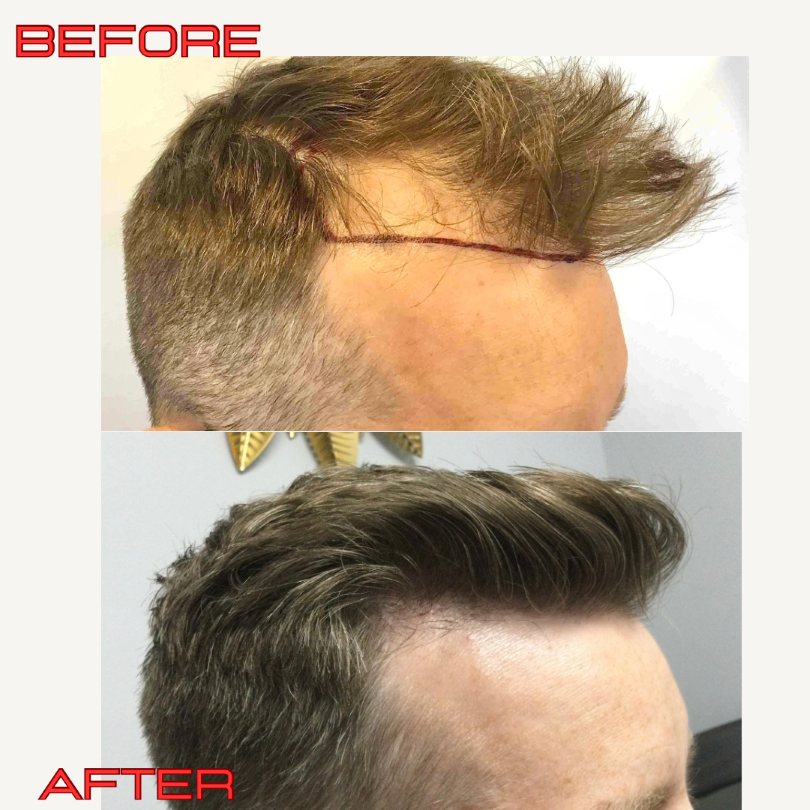 If you are in the early stages of hair thinning and loss, non-surgical hair loss treatments probably will be recommended initially. For men and women with advanced hair loss, our hair restoration surgeons will discuss hair transplant surgery. Dr. Matthew Lopresti and Dr. Mary Lopresti will take progressive hair loss into consideration when developing your customized treatment plan.
If you are in the early stages of hair thinning and loss, non-surgical hair loss treatments probably will be recommended initially. For men and women with advanced hair loss, our hair restoration surgeons will discuss hair transplant surgery. Dr. Matthew Lopresti and Dr. Mary Lopresti will take progressive hair loss into consideration when developing your customized treatment plan.
For most of our patients, we recommend utilizing a multi-modality approach, a combination of surgical and non-surgical therapies, to optimize your outcome. This provides the patient stabilization of their non-transplanted hair plus newly transplanted hair in thinning or balding areas to enjoy for the rest of their life.
What Are the Different Types of Hair Transplant Surgery?
There are two methods to harvest grafts in the hair transplant procedure: the traditional strip method and the Follicular Unit Excision (FUE) method. Each approach offers unique benefits and considerations. Dr. Matthew Lopresti and Dr. Mary Lopresti can review each modality and guide you in selecting the ideal approach based on your anatomic characteristics and expressed goals. Additionally, non-surgical options are always recommended as an alternative, or in addition to, a hair transplant procedure, to optimize your outcome.
Traditional Strip Harvesting
During a hair transplant, hair is redistributed from the donor site located in the back of the head to the balding or thinning areas on top. These grafts are placed to create a natural-appearing result. The new hair follicles act as your normal hair, growing at the same rate as the rest of the area. The procedure can help you achieve a fuller head of hair with natural-looking results.
Learn More About Hair Transplantation
Follicular Unit Excision (FUE)
An advanced method of hair restoration, Follicular Unit Excision (FUE) offers an alternative to traditional strip harvesting technique. With this method, no linear donor scar is created and natural-looking results can be achieved with greater comfort than ever before.
Learn More About Follicular Unit Excision
What Does the FUE Transplant Involve?
Over the years Follicular Unit Excision (FUE) hair transplants have grown more and more popular with our patients. This technique is a fabulous option for patients who prefer to keep their hair short in the back since it does not leave a linear scar. Additionally, patients who live an active lifestyle, such as professional athletes, prefer the FUE hair transplant as they can resume their physical activity shortly after surgery day.
In order to perform a FUE procedure the donor site located in the back of your scalp will be trimmed to the skin prior to beginning the transplant. Dr. Lopresti recommends having your hair cut to a “tight military buzz” or “bald fade” a few days prior to surgery. This method of hair transplantation involves being in the office for around 6-8 hours, so our patients arrive early in the morning on the day of their procedure. Patients can drive themselves to the office on the day of the FUE procedure.
Step 1: Preparation with Dr. Lopresti
On the day of your procedure Dr. Lopresti will take photos and carefully design and draw your newly transplanted area with a marker so that, together, you can finalize the plan. During a FUE hair transplant it is necessary for our patients to lie facedown for long durations while the grafts are harvested by Dr. Lopresti. A local anesthetic is injected into the scalp to numb the area. This injection process causes a slight pinch and burning sensation and generally takes between 3-4 minutes. Once completed, the remainder of the procedure is extremely comfortable.
Step 2: Donor Site Harvesting
Our Chief Surgeon Dr. Matthew Lopresti manually extracts each follicular unit carefully from the scalp. This part of the procedure requires an extreme amount of skill and experience with sophisticated instruments to provide an optimal outcome for our patients. We take great pride in providing safe and efficient FUE hair transplant procedures with minimum operative time.
Step 3: Grafting & Placing Hair Follicles
Using extreme precision, tiny little incisions are made into the skin, into which these tiny grafts are then planted. Dr. Lopresti makes these incisions following the direction of hair growth and the angulation from the surface of the scalp. Our highly skilled team members take great care inserting the grafts into the incision in the proper direction to ensure optimal results.
Step 4: Post-Operative Care
At the conclusion of the FUE hair transplant the recipient and donor sites are thoroughly cleaned. We then place a bandage on the donor site to keep it covered until it can be removed the day after surgery. Post-operative instructions are reviewed and patients can then drive themselves home.
What Does the Traditional Strip Method Transplant Involve?
Step 1: Preparation
During a traditional strip method procedure our patients sit in a comfortable chair designed specifically for hair transplants. Our patients are awake the entire time and drive themselves to and from our office on the day of the hair transplant. Patients are able to watch movies or television and are typically not able to feel anything other than a touching and/or pressure sensation. The procedure will take about four to five hours.
Step 2: Donor Site Harvesting
To begin, we lift the hair up in a row in the back with hair clips, shave about a half inch band of hair and then numb it with a local anesthetic. A strip of skin with these shaved follicles is then harvested and placed in saline solution for hair transplantation. That small incision is sutured together, we remove the hair clips and the hair will shingle right over the sutured area in the back of the head—and it’s completely hidden.

Step 3: Grafting & Placing Hair Follicles
Under magnification, the follicular units from the donor strip are dissected by our staff that have only one hair, two hair, and three hair grafts. These grafts are then placed in saline solution. The area that is bald or thinning is made numb by a local anesthetic.
Then, very small incisions are precisely made into the skin, in which these tiny grafts are then planted. Dr. Lopresti creates these incisions in a way that follows hair growth direction, as well as the angulation from the surface of the scalp. Once these are in place we shampoo the patients’ hair and they leave our office without any bandages.
Step 4: Post-Operative Care
When the hair transplant procedure is complete most patients experience soreness in the donor site where the sutures are. Extra-Strength Tylenol® is primarily used for post-operative medication, but a stronger medication can be prescribed if needed. Approximately 10-14 days later the patient comes into our office to have their sutures removed. This simple process takes 15-20 minutes and the sutured area will heal in a line. In most individuals, it’s a fine line about the width of a pencil line, and it is completely covered by your hair.
What Can I Expect After Hair Transplant Surgery?
The hard part comes after hair transplant surgery, which is waiting for the new hair to grow. The hair in the transplanted grafts will begin to grow about a ¼ inch in height initially and may fall out after approximately three to four weeks — but don’t worry! This is an expected physiologic situation. The little hairs in the grafts grow out of the grafts, making room for the same follicle to create a new hair that will grow. This is the standard shedding process, and your new hair should begin to grow in again in about three or four months. It’s a long period to wait and patience is your best friend during this time. Approximately six months after the hair transplant is when we really can see the new hairs that have grown to a length creating a visual change. This is your own natural, growing hair that you can style however you wish. If you have any questions about this process, don’t hesitate to reach out to our team.
When Will I See My Hair Transplant Results?
Patience is required, but the results are well worth the wait. Between 9-12 months after the hair transplant is when patients typically see the most impressive difference in density. However, at around 16-18 months post-operatively is when everything will have grown through the skin and the final results are achieved. This is your own growing hair that can be cut, colored, and styled.
“I am so pleased that I took this step and did something about losing my hair. It has been just a year since I had the surgery and I can’t believe the improvement and the wonderful results! Even my hairdresser told me that my hair is so fuller now she forgot I even had a problem. ”
Will My Hair Transplant Leave a Visible Scar?
Depending on the hair transplant harvesting technique used, there may be a fine linear scar hidden under your hair. With the traditional strip method, a pencil line scar will be in the back of your scalp that will not be visible unless you wear your hair short in the back. If the FUE procedure is performed, there will be small white “speckled” scars remaining in your donor area. However, they typically are not particularly noticeable, even with a short haircut in the back. Dr. Matthew Lopresti and Dr. Mary Lopresti will provide additional details about what to expect from the final result during your first meeting.
Will I Need Another Hair Transplant in the Future?
Hair transplant surgery is designed to provide additional density in thinning or balding areas on the scalp. That said, if you have male or female pattern hair loss, you could continue to lose hair where your genes dictate you will. Hair loss is a progressive condition and, if left untreated, you increase the likelihood of having another hair transplant. While the transplanted grafts should not fall out, other hair on the scalp probably will continue to recede. We will evaluate your hair quality and condition when we develop a customized treatment plan.
Our physicians will let you know if additional treatments will be necessary and help you formulate a long-term approach to stabilizing, preserving, and restoring your hair. It is typical that these non-surgical therapies will be necessary.
Hair Restoration for Women
Often in our American society, it’s considered “normal” for a man to lose his hair; it is not so for women. Though perhaps a somewhat discomforting experience for many men, it is not considered unusual. Unfortunately, treating hair loss or baldness in women frequently does not receive that same openness by the public.
At Leonard Hair Transplants Associates, approximately 15 percent of our surgical patients are women. Compared to a typical hair restoration surgeon’s practice, this number is quite high, which we believe reflects our surgeons’ true commitment and leadership in the field of hair restoration for every individual—man or woman.
Dr. Matthew Lopresti and Dr. Mary Lopresti encourage women experiencing hair loss to seek out our hair restoration services without hesitation, fear, or embarrassment. We welcome the opportunity to evaluate any patient who is concerned about her lost or thinning hair.
Learn More About Hair Restoration for Women
Hair Restoration for Transgender Patients
Our surgeons have had many years’ experience treating transgender patients. They have helped numerous male patients transitioning to their true identity as women with various hair restoration solutions. While hair loss is normal in men, it is not as prevalent in women, making a receding hairline or balding especially unpleasant for a transgender woman. Dr. Matthew Lopresti and Dr. Mary Lopresti work with their transgender hair transplant patients with care and understanding, recommending the best treatments for their needs.
Learn More About Transgender Hair Restoration
Can Facial Hair Be Transplanted?
In addition to restoring a fuller head of hair, our surgeons perform eyebrow restoration to create a thicker brow appearance. This includes non-surgical and surgical treatments that can effectively address or camouflage hair loss caused by genetics, excessive plucking, disease or disorder, or another concern.
Learn More About Eyebrow Restoration
Are There Non-Surgical Treatments to Help Regrow Hair?
We offer a comprehensive range of state-of-the-art minimally invasive and non-surgical treatments for hair loss such as PRP with ACell® Injection Therapy, Propecia®, and Rogaine® Foam. These methods can be used in conjunction with hair transplant surgery or as alternatives to the procedure if the patient is not yet a candidate. During your initial consultation, we can discuss your desired outcome and unique needs to determine the best course of action.
Additional Frequently Asked Questions About Hair Transplants
Is There a Best Time to Have My Transplant?
The time of year or season will not have an effect on your hair transplantation procedure. The sooner you begin, however, the sooner you’ll be able to see results and hair growth. Prior to surgery, further progression of hair loss can be treated with medical therapy, such as Platelet Rich Plasma (PRP) with ACell® injection therapy, Propecia® and Rogaine Foam®. In some cases, it can be too soon to begin hair restoration surgery. Since each patient’s circumstance is different, the one-on-one evaluation with Dr. Matthew Lopresti and Dr. Mary Lopresti will help determine which hair loss treatment will best benefit you.
What Is a Good Age for a Hair Transplant?
There is no “perfect” age for a hair transplant. At our offices, we have patients ranging from their early twenties to their early nineties. Good candidates for the procedure, however, are men and women who have realistic expectations of the results, and what can be achieved after a proper examination of one’s scalp. An adequate donor area is also necessary. Because each individual is unique, only an honest evaluation with a hair restoration professional can help someone decide when a transplant is most appropriate for them.
Will I Be Awake During Hair Transplantation Surgery?
Yes, hair transplant patients are completely awake and alert during the procedure. Since only a mild, local anesthetic is used, patients are able to watch television, movies, or read while they sit in a comfortable chair. If, however, you would prefer a mild sedative for the surgery, it can be arranged.
How Long Does the Hair Transplant Procedure Take?
Generally, a typical strip harvesting surgery will take around 5 hours, while the Follicular Unit Excision (FUE) technique requires patients to be in the office for up to 8 hours. The time of surgery also depends on the size of the session.
Can Someone Else’s Hair Be Used to Transplant?
No, using another individual’s hair is not possible because of the way foreign tissue is rejected. However, thanks to advances in the field, hair follicle banking from HairClone® is a revolutionary option that allows people to save healthy hair follicles before they start balding. Over time as their hair starts thinning, they can choose to clone and re-inject the follicles back into their scalp to preserve their full head of hair.
Do You Perform the Hair “Plug” Transplants?
No! We have not used the hair plug technique for over 38 years. The hair plug technique was developed in the 1950s, and was widely used up until the late 1980s. Today’s methods have advanced with state-of-the-art precision and smaller hair grafts, consisting of only 1 to 4 hairs.
How Long Will the Hairs Be Immediately After the Transplant?
The hairs are typically a few millimeters in length immediately following the hair transplant procedure. Once transplanted, the new hairs sometimes give the appearance of growing but in actuality are just being thrust out. Within a 2-3 week period, almost all of the newly transplanted hairs will have shed. Approximately three to four months following this initial shedding, the new growth of hair begins.
When Can I Start Exercising Again After My Transplant Surgery?
You can typically resume light exercise four days after the procedure. Once the donor area stitches have been removed, you can then resume your weight training. With the FUE procedure, you may resume weight training sooner.
Is It Okay to Wear My Hairpiece After Surgery?
For the first three days after hair transplant surgery, you should not wear a hairpiece, as your scalp should not be confined in any way. Dr. Matthew Lopresti and Dr. Mary Lopresti also advise that hairpieces be worn as little as possible following surgery for several reasons. First, it can delay healing and regrowth, and second, it’s important for patients to psychologically adjust to being more comfortable without it. Your own hair is now on its way to growing, and you will no longer have use for your hairpiece.
When Will the Hair Start to Grow?
Patients can expect to see normal hair growth four to five months following their hair transplant procedure. In some circumstances, hair growth may be slower due to individual variation or multiple surgeries. However, all patients can expect the normal growth rate to occur, which is 1/4 inch per month. Final results are typically achieved 18 months after the hair transplant procedure date.
Can I perm or color my new hair?
Yes! Because transplanted hair is your own growing hair, you will be able to perm, color, cut, curl, and style your hair as you normally would. Like the rest of the hair on your head, transplanted hair will grow at about the same rate, which is 1/4 inch per month.
Schedule Your Hair Transplant Consultation
If you have thinning hair but have not yet come in for a hair loss consultation, we encourage you to schedule one as soon as possible. For our patients who have already successfully undergone their hair transplantation surgical procedure, we invite you to schedule your follow-up examination with Dr. Matthew Lopresti and Dr. Mary Lopresti. For more information on whether hair transplantation may be the right solution for you, please contact us today!



